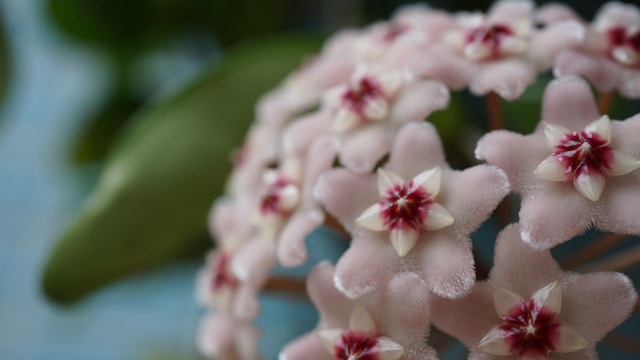From Wax Flowers to Porcelain Plants: Exploring the Diverse World of Hoya Varieties
The Hoya genus, commonly referred to as wax flowers due to their glossy, wax-like leaves, captivates gardeners and plant enthusiasts around the world. These intriguing plants, renowned for their charming flowers and low-maintenance nature, have earned a special place in indoor gardening. This article delves into the diverse world of Hoya varieties, exploring their unique characteristics, care requirements, and the allure they bring to our homes.
Understanding the Hoya Genus
The Hoya genus, belonging to the Apocynaceae family, encompasses over 200 species of tropical plants. Native to regions like Southeast Asia and Australia, Hoyas are celebrated for their distinctively fleshy leaves and stunning, star-shaped flowers. Botanically classified within the Apocynaceae family, Hoyas are known for their varied forms and growth habits, which range from climbing vines to compact, bushy plants. Their common features include thick, waxy leaves that store moisture, making them well-suited for indoor environments. The genus is distinguished by its diverse flower shapes, which often have a unique, sweet fragrance.
Popular Hoya Varieties
One of the most beloved members of the Hoya plant family is the Hoya Carnosa. This species is easily recognizable by its thick, waxy leaves and clusters of star-shaped flowers. Among its varieties, the 'Krimson Queen' and 'Krimson Princess' stand out. The 'Krimson Queen' features striking green leaves edged with creamy white, while the 'Krimson Princess' boasts pinkish-red margins. These varieties are celebrated for their ability to thrive in various lighting conditions, from bright indirect light to lower light levels. Proper care involves providing well-draining soil and watering when the top inch of soil feels dry. Regular feeding with a balanced fertilizer will encourage robust growth and prolific flowering.
The Hoya Pubicalyx is another favorite, known for its attractive, dark green leaves and impressive blooms. This species exhibits a variety of forms, with some having pubescent (hairy) leaves that add texture. Notable varieties include the 'Black Dragon,' which features deep burgundy flowers, and the 'Silver Splash,' recognized for its striking leaf variegation. Caring for Hoya Pubicalyx involves providing a well-draining potting mix and ensuring that the plant receives bright, indirect light. Watering should be done when the soil is dry to the touch, and occasional misting can help maintain humidity levels.
The Hoya Obovata is distinguished by its large, rounded leaves and clusters of creamy-white to pale pink flowers. This variety is particularly appreciated for its robust growth and ease of care. The plant’s leaves are often mottled with silver, adding a touch of elegance. To keep Hoya Obovata thriving, provide it with a well-aerated potting mix and place it in a location with bright, indirect light. Watering should be moderate, allowing the soil to dry out between waterings. Fertilizing during the growing season will support healthy foliage and flowering.
Rare and Exotic Hoya Varieties
The Hoya Wayetii is a rare variety that stands out with its unique leaf shape and subtle fragrance. This Hoya has long, narrow leaves that add an exotic touch to any collection. To care for Hoya Wayetii, provide it with bright, indirect light and a well-draining soil mix. Watering should be done sparingly, allowing the soil to dry out between waterings. Regular feeding will support healthy growth and flowering.
Hoya Cumingiana is another exotic variety known for its distinctive, waxy leaves and charming flowers. The plant’s foliage often features a unique texture, and its flowers are typically small but striking. To cultivate Hoya Cumingiana successfully, provide bright, indirect light and a well-aerated potting mix. Watering should be moderate, allowing the soil to dry out between waterings, and occasional feeding will help maintain its health and vigor.
Hoya Flowers: A Detailed Look
Hoya flowers are renowned for their unique shapes and vibrant colors. The star-shaped blooms often appear in clusters, creating a stunning display. The flowers come in various colors, including white, pink, red, and even purple, with some varieties featuring intricate patterns or gradients. Hoyas typically bloom during the warmer months, with some species flowering multiple times a year. To encourage blooming, ensure the plant receives bright, indirect light and avoid overwatering. Regular feeding with a balanced fertilizer can also promote more frequent and abundant blooms.
Growing Hoyas requires attention to their specific needs. These plants thrive in well-draining soil, which helps prevent root rot. A mix of potting soil, perlite, and orchid bark is ideal. Hoyas prefer bright, indirect light but can tolerate lower light conditions, although flowering may be reduced. Watering should be done when the top inch of soil is dry, and overwatering should be avoided. Hoyas also benefit from occasional misting to maintain humidity levels. Fertilize the plants during the growing season to support their growth and flowering.
Conclusion
The diverse world of Hoya varieties offers a wealth of options for plant enthusiasts. From the classic Hoya Carnosa to rare species like Hoya Cumingiana, each variety brings its charm and beauty. Understanding their unique characteristics and care requirements allows gardeners to appreciate and cultivate these fascinating plants successfully. Whether you are a seasoned collector or a novice gardener, exploring Hoyas can enhance your indoor garden with its stunning foliage and exquisite flowers.

